
Top 10 Things to Do for Tibet Culture Tour
Tibet is a vast region on the high-altitude plateau that is known as the roof of the world, and the culture is diverse and unique. Buddhism, the soul of Tibetan culture, is the predominant religion in the region and is evident in the daily lives of all Tibetans. One of the main reasons people visit the plateau is to learn more about this unique culture, which is so closely intertwined with their religion. The two are not mutually exclusive in Tibet, and you cannot have one without the other.
This unique culture has developed over thousands of years to be the Tibetan culture we know today and can be seen in the diet of the Tibetan people and their unique crafts. Tibetan Buddhism includes some of the most unique and amazing festivals in the world, and the plateau is the only place in the world where you can see a festival based around the eating of yogurt. This strange and unique culture has been well maintained due to the remoteness of the region and its isolation from the outside world for many centuries.
Explore the Potala Palace and Jokhang Temple
In Lhasa, you can visit two of the most popular sights in the region, the Potala Palace and the jokhang temple. Potala Palace, built in the 17th century, was named after the mythical home of the bodhisattva Avalokitesvara, the legendary Mount Potalaka, and was designed as the seat of governance in ancient Tibet. Built on the site of a former fortress from the 7th century, part of that fortress still exists in the west of the palace. The palace contains three main halls, that tradition says represent the “Three Protectors of Tibet”, Chokpori, Pongwari, and Marpori.
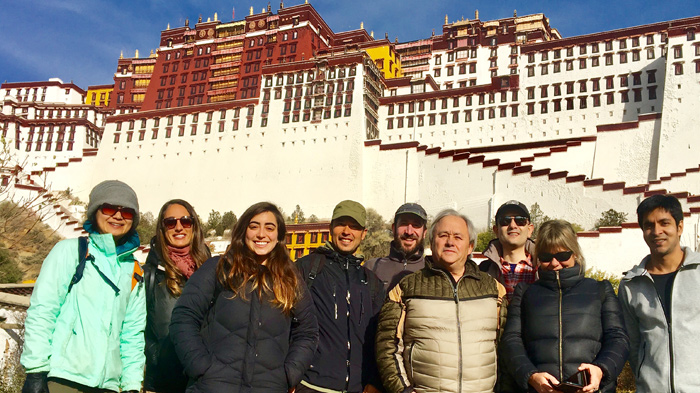 Group photo of tourists before the majestic Potala Palace
Group photo of tourists before the majestic Potala Palace
Jokhang Temple, in the center of Lhasa, is one of the oldest Buddhist buildings in Tibet, and is the most sacred temple in the region, housing the statue of Buddha Sayamuni at the age of twelve that was brought to Tibet from the Tang Dynasty. Built in the 7th century by the Tibetan king, Songtsen Gampo, this temple is a major site for Buddhist pilgrims.
Enjoy the Barkhor Kora in Barhor Street
Barkhor Street in Lhasa is more than just a street full of shops selling all kinds of local handicrafts and Tibetan clothing and other items. While you can spend hours strolling through the many shops to find the perfect gift for those back home, you can also spend that time walking around the kora route that runs around the Jokhang temple. Barkhor Street runs all the way around the temple site, and is the route of the ritual kora for the Buddhist pilgrims that travel there. Taking the sacred ritual walk is an experience that you will never forget, and you can experience how it feels to be a pilgrim.
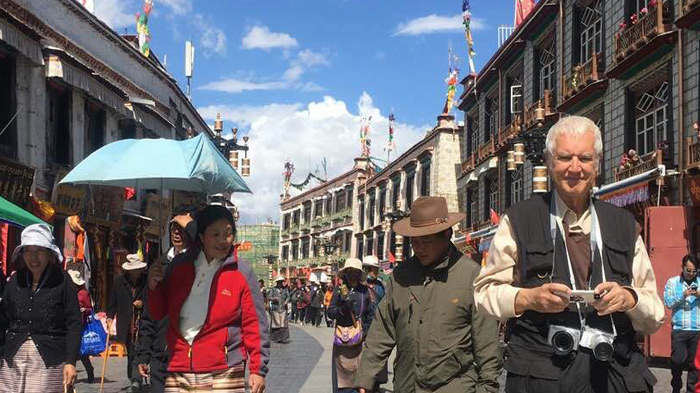 Follow the Barkhor Kora with local Tibetans
Follow the Barkhor Kora with local Tibetans
Savor the Great Atmosphere and Sweet Tea in Local Tea house in Lhasa
In Lhasa, teahouses are the cafes of the Tibetan plateau, and are often filled with locals, sitting around drinking tea and chatting. They are an integral part of the Lhasa culture, just as much as sweet tea and butter tea are major parts of Tibetan culture across the plateau. These uniquely decorated teahouses are great places for socializing and are an amazing source of local knowledge. They do not just serve tea, as well. You can also get dinner here and try out some of the tasty Tibetan cuisine. - Check Sweet Tea House in Lhasa
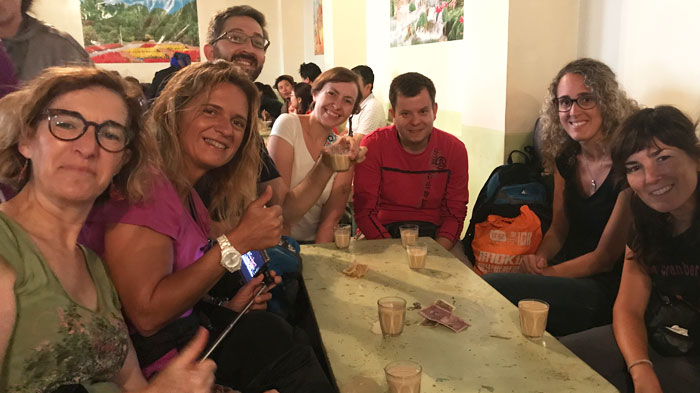 Our clients were enjoying the sweet tea in a local tea house.
Our clients were enjoying the sweet tea in a local tea house.
Stroll in the Old Street and Bazaar in Lhasa
Lhasa old town has an ancient feel to it, and some of the streets and houses there date back almost as far as the Jokhang Temple itself. This ancient part of town is an awe-inspiring experience, with cobbled streets and alleys crisscrossing the old quarter of the city. Eventually, you are likely to end up at the famous Tromsikhang Market, a huge bazaar-like area which has a wide selection of fruits and nuts available, imported from Xinjiang. You can also find the best Tibetan delicacies, such as tsampa, yak cheese, and special yak butter for your tea.
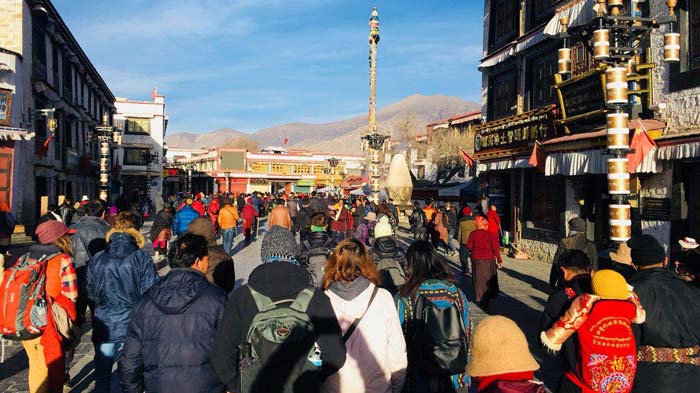 Taking a stroll along the bustling Barkhor Street
Taking a stroll along the bustling Barkhor Street
If the stunning Tibetan thangka paintings are of interest to you, you can join in one of the classes in the old town where you can learn how the thangka paintings are made, and even try to make one yourself. Thangkas, the special Tibetan paintings of deities and Buddhas on silk cloths, are one of the most important parts of the cultural religious festivities in Tibet and can be seen at many festivals being unveiled as giant paintings covering whole hillsides.
Enjoy the Princess Wencheng Real-scene Musical in Lhasa
One of the most spectacular cultural events of the modern day in Lhasa is the Princess Wencheng Show, a live-stage show that introduces a major character in Tibetan history and culture. The stage show tells the epic tale of a young Tang Dynasty princess that was sent to marry the Tibetan king, Songtsen Gampo, to secure a peace between the Tubo Kingdom and the Tang Dynasty of China. Showing the events that took place more than 1,300 years ago, the story is one of the most stunning attempts of recreating parts of Tibetan and Chinese history. - Epic Tibetan Drama Unfolds: Never Miss the Princess Wencheng Real-scene Musical in Lhasa
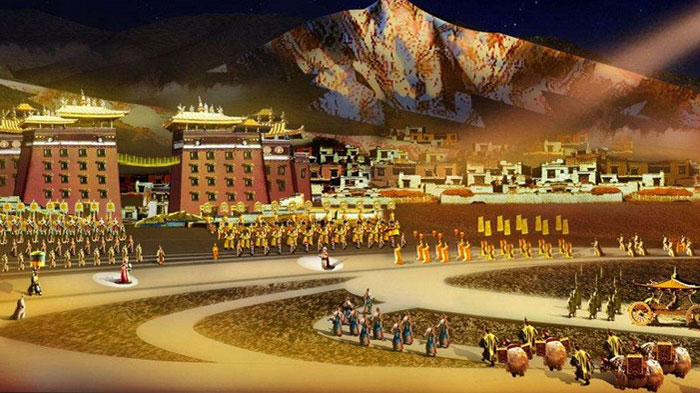 Princess Wencheng Musical Show is a splendid live stage show of Tibet culture.
Princess Wencheng Musical Show is a splendid live stage show of Tibet culture.
Watch the Monk Debate in Sera Monastery
Sera Monastery, one of the “great three” monasteries of the Gelugpa School of Tibetan Buddhism, is also one of the most spectacular places to visit in Lhasa. This ancient monastery, built in around 1419, includes 19 hermitage sites and caves, as well as four nunneries, all of which are located in the foothills around Lhasa, and which make a great day-hiking tour. However, Sera is more well-known for its eye-catching monastic debates. Every afternoon, the young monks retire to the outside courtyard, where they debate on the philosophical aspects of the Buddhist doctrines. Debating between teacher and pupil, the heated discussions are very energetic, with much hand-clapping and jumping around, as each puts across his side of the debate, in loud and enthusiastic voices. - Monk Debate: A Bizarre Test of Tibetan Buddhism Study in Tibet
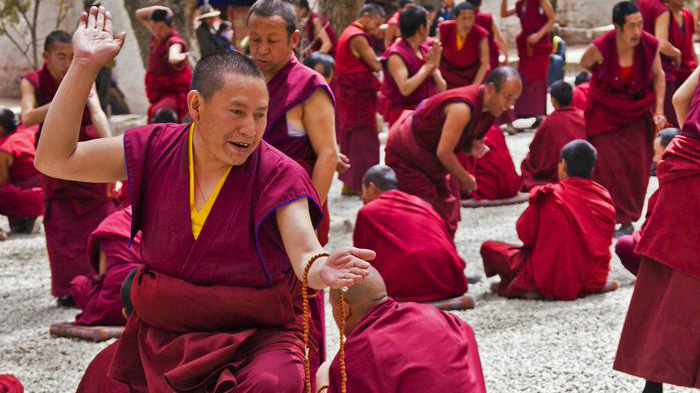 Watching Tibetan monks debating in Sera Monastery
Watching Tibetan monks debating in Sera Monastery
Go for Linka (picnic ) with Local Tibetans in Norbulingka during Shoton Festival
Once the center of Tibetan government and the summer palace of the Dalai Lama, Norbulingka is a palace and huge park in Lhasa. Built in 1755 to replace the Potala Palace as the center of local Tibetan governance, Norbulingka is now a historical and cultural site and a major park where locals take their families for picnics in the spring and summer months. The palace is also the site of one of the most popular festivals in Tibet, in Lhasa; the Shoton Festival. A major religious celebration commemorating the ancient days of fasting for the monks, who would be given milk curd by the local people after their 100-day fast, the celebration now uses yogurt instead, and is more often known as the Tibetan Yogurt Festival to tourists. Shoton is one of the best times to visit the park for a picnic with the local Tibetans, and to experience this unique cultural and religious spectacle at its best.
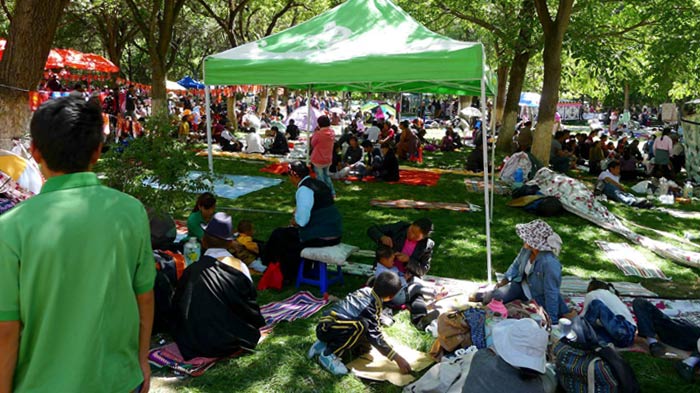
Residents of Lhasa were enjoying Linka Festival in Norbulinka.
Visit the Samye Monastery, 1st Tibetan Monastery in Tibet
The first monastery or gompa built in Tibet, Samye Monastery in Shannan Prefecture, to the south of Lhasa, was constructed between 775 AD and 779 AD. Under the patronage of the Tibetan King, Trisong Detsen, who wanted to revitalize the Buddhist religion in Tibet, the monastery was built on an auspicious site, according to the Indian monk, Santaraksita. It was not until the arrival of Padmasambhava, the Indian Buddhist master known in Tibet and Bhutan as the guru Rinpoche, that the site was cleared of the demons that the locals believed were hindering the building of a temple on the site, that the monastery’s construction was completed. Despite having been destroyed and rebuilt several times, it remains an important site for Tibetan Buddhism and for the pilgrims that journey there.

Having an aerial view of the holy Samye Monastery.
Tour the Prestigious Tashilhunpo Monastery in Shigatse
Founded by the first Dalai Lama in 1447, the Tashilhunpo Monastery in Shigatse, Tibet’s second city, is one of the most unique monasteries in the world. A historically and culturally important gompa, the monastery is the only one of its kind, and uniquely houses three separate schools of Tibetan Buddhism under one roof. Described by an officer of the East India Company in the 18th century as being the most beautiful building in the world, and a sight that would never dim in his mind, this unique monastery is also the seat of the Panchen Lama, Tibet’s second highest incarnation.

The grand Tashilhunpo Buddha Exhibition Festival holds in Tashilhunpo Monastery, Shigatse.
Walk with Tibetan Pilgrims around Mt. Kailash during Saga Dawa Festival
In the west of Tibet, standing 6,638 meters above sea level, lies the most sacred mountain in the world. Known locally as Gang Rinpoche, it is probably better known as Mount Kailash, and is deemed to be the center of the universe for four separate religions. This sacred mountain, held to be the legendary Mount Meru in Buddhism and Jainism, Kailāsa in Hinduism, and the “nine-story swastika mountain”, or the “axis mundi” in Bon, is the site of the famous Saga Dawa festival in Tibet, held in June in the Gregorian calendar.
 People do kora around Mt. Kailash during Saga Dawa Festival
People do kora around Mt. Kailash during Saga Dawa Festival
As one of the most sacred places in the world, the mountain sees hundreds of thousands of visitors every year, from Indian and Tibetan pilgrims to foreign tourists heading for the sacred mountain. Around the mountain is a 2-kilometer-long kora trail that is one of the most meritorious in Buddhism and Hinduism. Kailash kora route, which is also the most popular trekking route in Tibet, is said to be an auspicious ritual kora, and those who complete one circumambulation will have all their sins absolved.
The Saga Dawa festival, which is held every year at Darchen, at the foot of the mountain, is one of the biggest festivals of the year, where the Tarboche flagpole is lowered and reset with new prayer flags, to be hoisted aloft again to allow the wind to blow the good blessings across the world. A ritual filled with prayers, chanting, and smoking branches, the pilgrims then make their way around the mountain’s kora route, many of them covering the entire 52 kilometers in just one day, a feat that takes the average trekking tourist three days.

I am a tour guide in Tibet an was Born in Kham Tibet, I am the father of 2 little girls, bachelor's degree. I have more than 7-years experience of being a tour guide in Tibet. I am a warm, friendly, knowledgeable and attractive guy.


.jpg)




0 Comment ON "Top 10 Things to Do for Tibet Culture Tour"